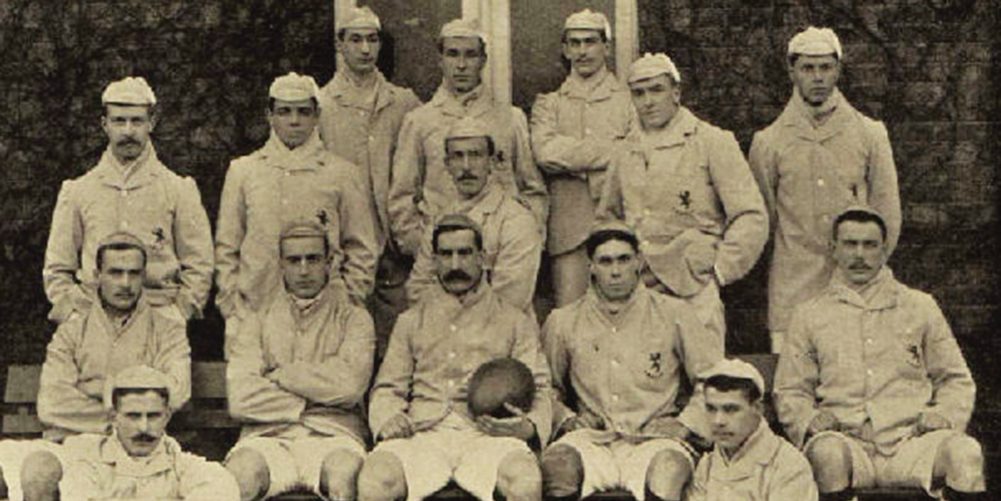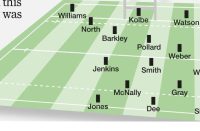Brendan Gallagher continues his series looking at rugby‘s great schools

THE school motto of Fettes, the famous Edinburgh school, is – Industria – which loosely translates as ‘by diligence’. Which is odd as Fettes, certainly on the rugby field, has tended to produce idiosyncratic players of genius, huge characters, large than life individuals.
Worthy plodders have been few and far between. . .nor would their most famous fictional alumni – James Bond no less – ever be described as a journeyman.
Thomas Torrie was the first Fettes player to be capped -in 1877 against England – after which he left for Ceylon to run a tea plantation, and another early star was Don Wauchope, a solidly built but extremely skilful half-back, who was at the heart of two of Fettes best early sides in 1876 and 1877 Another larger-than-life Fettes old boy was John Argentine Campbell, born in Buenos Aires, who captained Cambridge to a 22-0 win in 1899 in his third Varsity Match . He went on to win one cap for Scotland in 1900, giving him the distinction of being the first Argentine-born player to play international rugby.
An athletics Blue, he also played cricket for Argentina and, as a nine-goal polo player, was one of the highest rated in the world at the time. Only one British player in history – Gerald Balding, grandfather of broadcaster Claire – has ever been ranked higher.
Campbell returned from his ranch to serve in World War 1 when, as a Lieutenant in the 6th Dragoons (Inniskilling), he was reported missing in action in France on December 1, 1917, and died of wounds in a German field hospital a day later at the age of 40.
His son, JD ‘Jock ‘ Campbell played at Twickenham in 1927 for Cambridge having also gone to Fettes while his grandson, also Jock, is now in charge of the ranch in BA having also attended Fettes and Cambridge.
A contemporary of Campbell at Cambridge was another Fettes luminary, William Wotherson, an exciting talent as a schoolboy who lost little time in making an impact at Test level, scoring a sensational hat-trick on his Scotland debut, against Ireland in 1891. That was enough to earn selection for the British Isles team to tour South Africa in 1891 when he played in one Test, partnering Arthur Rotherham at half-back in the first Test at Port Elizabeth, a game the tourists won 4-0.


One of the biggest names in Fettes rugby history is David Bedell-Sivright, a fearsome forward of volcanic temperament who was the hard man in the Scotland pack between 1900- 1908, winning 22 caps during that period while he also went on two Lions tours in the space of a year – to South Africa in 1903 and then Australia and New Zealand the following year. He suffered serious injuries on both trips, including a broken leg in 1904, and played in only one Test match.
Bedell-Sivright – whose brother John also went to Fettes and played for Scot- land – was a member of a Fettes XV which famously spawned six future internationals.
Curiously they were considered a mediocre side for the period and lost more games than they won. He went up to Cambridge in 1899 to read medicine and to pursue his hectic rugby career which badly interrupted his studies. After retiring from Test rugby in 1908 to concentrate on his work as a surgeon there was still time to become the amateur boxing champion of Scotland.
Various tales attach themselves to Bedell-Sivright, some may even be true, but the one that commonly gets mentioned was a late night incident in Princes Street when he rugbytackled a cart horse for reasons that nobody can recall.
Bedell Sivright, who became a surgeon with the Royal Marines during World War 1, died on September 5, 1915 in the Hospital ship HMHS Dunluce Castle anchored off Gallipoli.
He had been bitten by an unidentified insect while accompanying the landings a few days earlier and had fallen ill with a severe fever. He was inducted in the IRB Hall of Fame in 2013.
Another tough Fettes character in the Bedell-Sivright mould was lock David MacMyn who also became a surgeon.
MacMyn was a pupil at Fettes during World War 1 and, after playing for Cambridge and King’s Hospital, made his Scotland debut during their Grand Slam year of 1925.
During the three seasons before he retired to concentrate on his medical career, MacMyn packed in a lot of rugby, winning in ten of his eleven Scotland appearances, one of the best ratios ever for a Scot, and leading the 1927 Lions on their then unofficial tour of Argentina in 1927. He eventually chose to succeed his father as the GP at Kirkurkbright.
Another notable Fettes product between the Wars was innovative fly-half Herbert Waddell, who captained an outstanding Schools XV before joining Glasgow Academicals from where he won Scotland and Lions honours.His son Gordon mimicked his father’s rugby career in many ways – fly-half for Fettes, Cambridge, Scotland and the Lions – but in one notable respect he exceeded his dad, namely being a key player in the Cambridge XV of 1961 which is the only unbeaten Cambridge or Oxford side in history. The so-called ‘immortals’.


Waddell won three Blues in total during his time studying law at Pembroke College and was at the height of his powers having toured New Zealand with the Lions in 1959. It was in 1961 that the Light Blues put together the perfect term of rugby– P14, W14, F 249 A 49.
Those wins included triumphs over full strength sides from Cardiff, Newport, Gloucester, Leicester, Coventry, Bedford, Quins and Northampton.
Waddell also went on the Lions tour of South Africa in 1962 and settled there becoming a businessman and politician of some repute.
Another outstanding player from this era was prop Frans Ten Bos, the son of Dutch parents who evacuated him via Bordeaux during the early stages of World War 2, while a familiar name who taught at the school was Scotland fly-half and future BBC Rugby correspondent Ian Robertson.
In more recent times the Bell Lawrie Scotland Schools Cup has been something of a Holy Grail and after missing out in 2001 when they lost to Merchiston Castle in the final, they landed the title in 2009 when they beat Stewart’s Melville 39- 28 in one of the most entertaining modern finals.
Fly-half Kit Gammel scored two tries and kicked nine points but the MOM was probably livewire scrum-half Sam Hunt while wing Chris Giffin played a fine hand.
























Pingback: ย่างบนเตา
Pingback: ร้านแว่น สุขุมวิท